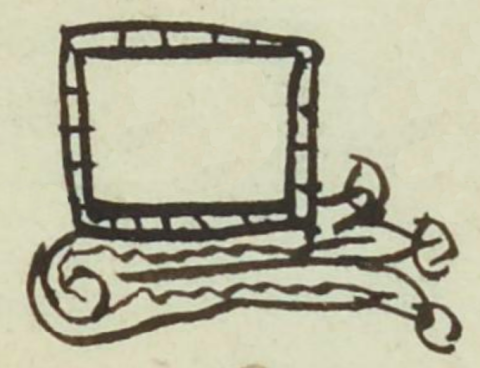Ayapan (MH530v)
This black-line drawing of the compound glyph for the personal name or place of origin, Ayapan (perhaps "Maguey Cloth Flag," attested here as a man’s name), shows a frontal view of a rectangular cloth (ayatl) with a segmented border around it. The cloth is undecorated inside the border and just left natural (not painted) by the author/artist. Underneath the cloth is a flow of water, perhaps a waterway (apantli). But, at minimum, the water is a phonetic indicator that this name begins with "A-." The water flows from the left (where there is a whirlpool or natural spring) toward the viewer's right. The three little streams have wavy lines of current (movement) and droplets/beads or shells at the tips of each stream. Perhaps the waterway is an apantli, perhaps also providing a phonetic indicator for the -pan part of the name.
Stephanie Wood
Ayapan was a fairly common place name, and several times it is used as a personal name. Four other glyphs for this personal name appear below. It could be a place of origin. A place named Ayapan exists in the state of Tabasco, Mexico (see: Daniel Suslak, “Ayapan Echoes,” American Anthropologist, Nov. 2011), and there may be others. If Ayapan is not literally about a flag, perhaps it refers to the medicinal plant, ayapana, so this could be the root of the name, and if so, the compound would be fully phonographic. This would be true, too, if the -pan is a locative, and the flag is another phonetic indicator.
1560
Jeff Haskett-Wood
water, agua, fabric, tela, cotton, algodón, cloaks, mantas, nombres de hombres

aya(tl), a thin cloak or blanket of cotton, maguey, or henequen fiber, https://nahuatl.wired-humanities.org/content/ayatl
a(tl), water, https://nahuatl.wired-humanities.org/content/atl
apan(tli), waterway, https://nahuatl.wired-humanities.org/content/apantli
Bandera de Ayate
Stephanie Wood
Matrícula de Huexotzinco, folio 530v, https://www.loc.gov/resource/gdcwdl.wdl_15282/?sp=140&st=image
This manuscript is hosted by the Library of Congress and the World Digital Library; used here with the Creative Commons, “Attribution-NonCommercial-ShareAlike 3.0 License” (CC-BY-NC-SAq 3.0).






